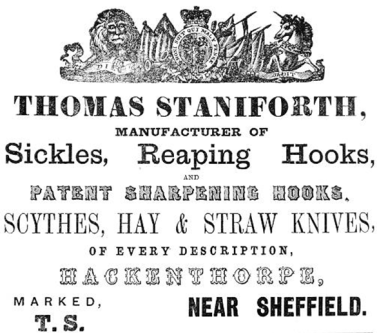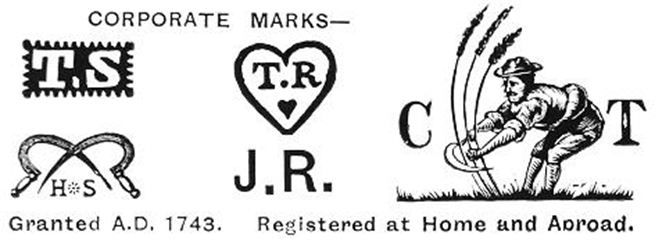Staniforth Family
The Staniforth family was very prominent in north Derbyshire for hundreds of years, when referencing the baptismal records between the 1600s and 1800s, there were hundreds of Staniforth’s in the Beighton/Hackenthorpe parish. Before entering the sickle trade the family was mainly involved in farming, with the earliest ancestor I have found so far being Henry Stannyforthe from Herdings farm, Norton.
The Staniforth works itself was setup by John, son of Samuel Staniforth (1675-1756), with the help of his brother Thomas. The works then passed down to each generation after that, Thomas (1721-1776) then Thomas (1756-1808) then Thomas (1785-1847).
The later Thomas is perhaps most notable for building up the business and expanding it into a thriving worldwide name. Steam power was introduced in the early 1800s which helped expand business however they continued to manually hand forge blade right up to the late 19th century.

The Shirebrook Valley, now a nature reserve where the Shire Brook flows through, originally had five water mills which were used to power the grinding wheels. The most notable of the wheels were Carr Forge (Who’s remnants can still be seen today), Cliff Wheel, Rainbow Forge (Again this can still be found).
Beside the Staniforth Works at Hackenthorpe is a large listed residence known as Greenside House, this was the residence of Thomas Staniforth abt 1825. Thomas Married Ann Hibbard (1785-1844) and their next son, also named Thomas (1810-1873) took his place in the business.
By 1851, as inicated in Census records and other articles from the time, the works had a workforce of abt 120 people, which is incredible when you think of the size of the Works itself. By the time of the 1861 census a total of 120 men and 26 boys were on the workforce. It was around 1872 when the Staniforth Works took on the name “Staniforth Works & Co”, and William (1839-1900), one of Thomas’s brothers was brought into the business. Around this time many of the Staniforth siblings married into the Hibbard family, we well known Handsworth family at the time. Son in law John Hibbard (1845-1923) who married Thomas & William’s sister Louisa Staniforth and Rowland Hibbard were also brought into the business. It should be noted that this was the first time a non-Staniforth was brought into a major role. Thomas died on 24 September 1873 and based on his will, left a sum of 7,000. After Rowland Hibbard left the business in 1874, the business passed to the next eldest son William (As mentioned above), and John Hibbard. As a side note, stories of John Hibbard seem rather sketchy to me, in my personal opinion he sought to take over the businesses, moving himself into Greenside House with Louisa and it has even been mentioned that William sought to extend a lease he had at Brookside Farm at the time and John forbade this and sent him spiraling into a drinking problem. Walter Staniforth (1841-1894) was another of William’s brothers that assisted in the business but as articles from 1894 show, he took his own life at Woodhouse, literally calling his wife into the back garden and slicing his throat in front of her. His grave can be found in Woodhouse Cemetery.
Back on track here, in 1874 the Staniforth Works took on the assets of a few companies most notably from the well known George Helliwell, another Scythe manufacturer in Hackenthorpe, and with the invent of machinery the company embraced machines which strained labour relations. By the 1880s the company was seeking to replace the workforce with machinery which caused an uproar. On 22nd February 1881 it was noted in the Sheffield Telegraph that an attempt to blow up the machinery was made by union workers, and Hackenthorpe was known far and wide for this event!

Trade began to decline from the 1890s onwards, in 1893 William Staniforth and John Hibbard parted ways and their partnership was dissolved. William filed for bankruptcy and retired to Heeley. He passed away at the age of 60 at Albert Road and it was remarked that his heavy drinking lead to his demise. John Hibbard continued to trade but continued to suffer losses. In 1911 the firm went into liquidation and John retired before passing away in 1923 at the age of 77, he left 13,188 in his will.
In 1912 the business and all of its assets were purchased by investors, the name Thomas Staniforth & Sons was used and with 7,000 and new directors the company was up and running again. It should be noted that by this time no Staniforths were on the Directors team.
The Company continued to function in the 20th century, creating the Severquick line of hatchets, but however it declined towards the later half of the century and ultimately close up shop in the 1980s.
Comments
Post a Comment